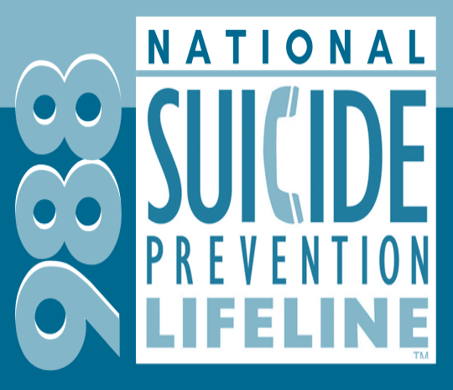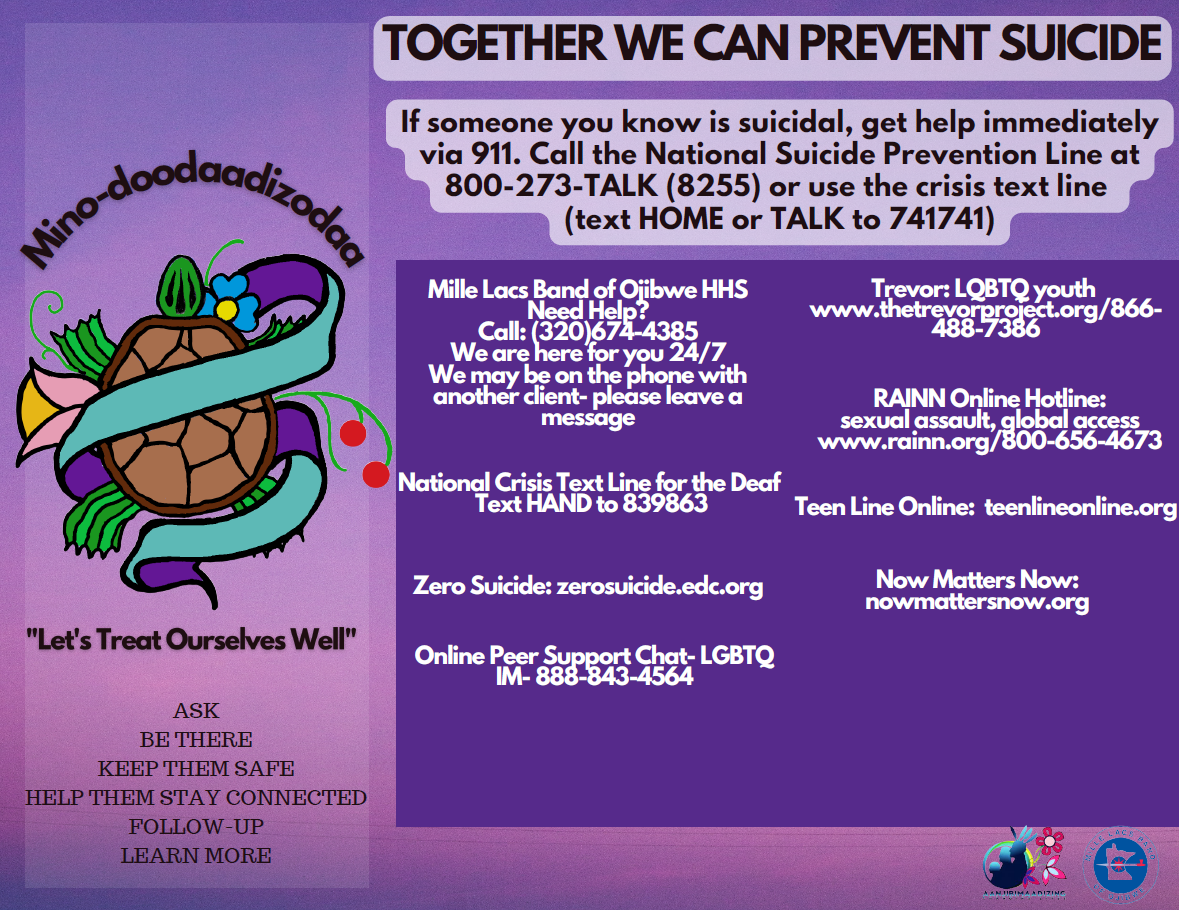Mille Lacs Band of Ojibwe Suicide Prevention Project
Suicide is an urgent issue in our community locally, and for American Indians across the state.
- American Indians have the highest rate of suicide in Minnesota.
- Aitkin County is ranked 1st in Minnesota for the highest suicide rate of any county in the state.
- The leading means/method of suicide amongst American Indians in Minnesota is suffocation (68%).
Suicide and substance use are connected issues. From 2016-2020, thirty-three Native people died by overdose in connection with Aitkin, Mille Lacs, and Pine County, with increases in 2019 and 2020. Statewide, overdose deaths increased in 2019 and 2020. Substance use isn’t criminal- these are our relatives struggling with mental health. Students who think adults in their community’s care about them are less likely to report past month alcohol use, marijuana use, and prescription drug misuse.
Prevention efforts must focus on youth.
- Youth ages 15-34 make up 55% of people who die by suicide among American Indians in Minnesota.
- Native youth are struggling with depression (58% of Native youth in Mille Lacs, 67% in Pine) and anxiety.
- Youth are struggling with suicide ideation (35% of Native youth in Mille Lacs, 55% in Pine) and suicide attempts.
- However, Native youth more frequently reported participation in an out of school time activities and programs – that’s a strong foundation we can build off of.
Suicide Prevention: Know the signs
The Native youth suicide rate is 2.5 times higher than the overall national average, making these rates the highest across all ethnic and racial groups. The American Foundation for Suicide Prevention notes that there is no single cause for suicide, there are risk factors and warning signs which may increase likelihood of an attempt. Learning them can save lives.
Risk Factors
Health
- Mental Health Conditions
- Serious physical health conditions including pain
- Traumatic brain injury
Environmental
- Access to lethal means including firearms and drugs
- Prolonged stress, such as harassment, bullying, relationship problems or unemployment
- Stressful life events, like rejection, divorce, financial crisis, other life transitions or loss
- Exposure to another person’s suicide, or to graphic or sensationalized accounts of suicide
Historical
- Previous suicide attempts
- Family history of suicide
- Child abuse, neglect, or trauma
Protective Factors
- Access to mental health care, and being proactive about mental health
- Feeling connected to family and community support
- Problem-solving and coping skills
- Limited access to lethal means
- Cultural and religious beliefs that encourage connecting and help-seeking, discourage suicidal behavior, or create a strong sense of purpose or self-esteem
Warning Signs
Most people who take their lives exhibit one or more warning signs either through what they say or what they do.
Talk
- About killing themselves
- Feeling hopeless
- Having no reason to live
- Being a burden to others
- Feeling trapped
- Unbearable pain
Behaviors
- Increased use of alcohol or drugs
- Looking for a way to end their lives, such as searching online for methods
- Withdrawing from activities
- Isolating from family and friends
- Sleeping too much or too little
- Visiting or calling people to say goodbye
- Giving away prized possessions
- Aggression Fatigue
Mood
- Depression
- Anxiety
- Loss of Interest
- Irritability
- Humiliation/Shame
- Agitation/Anger
- Relief/Sudden Improvement
Learn More: American Foundation for Suicide Prevention https://afsp.org/risk-factors-protective-factors-and-warning-signs
Suicide prevention resources are provided for informational purposes only. Providers and individuals should seek local qualified assistance in crisis situations or to address concerns related to the mental health and/or wellbeing of individual community members.
Suicide Prevention Contacts
It is recommended that you program at least one of these into your phone, so that you have it in the event of a crisis.
Emergency Medical Services: Dial 911
Mille Lacs Band of Ojibwe HHS: Need Help? Call 320-674-4385 to talk to a therapist. We are here for you 24/7.
National Suicide Prevention Lifeline: 800-273-8255 (TALK)
American Foundation for Suicide Prevention: Are you in a crisis? Call 800-273-8255 or text TALK, NATIVE, or TEEN to 741741.
Zero Suicide: zerosuicide.edc.org
WeRNative, My Mind, Ask Auntie and Uncle Text: CARING to 65664
Teens Helping Teens: Call 1-800-852-8336 or text TEEN to 839 863
Now Matters Now: nowmattersnow.org
Lifeline Crisis Chat: IM – 800-273-TALK
Online PEER Support Chat: LGBTQ, IM – 888-843-4564
RAINN Online Hotline: sexual assault, global access – www.rainn.org/800-656-4673
Veteran’s Live Chat: global access for American vets – www.veteranscrisisline.net also text 838255
Teen Line Online: teenlineonline.org
Trevor: LGBTQ youth www.thetrevorproject.org/866-488-7386
National Crisis Text Line for the Deaf: text HAND to 839863
Reach Out: www.Reachout.com
Boys Town Suicide and Crisis Line: 1-800-448-3000 or 1-800-4481833 (TDD)
Honoring Native Life: https://www.facebook.com/HonoringNativeLife/
Coming Soon!
988 has been designated as the new three-digit dialing code that will route callers to the National Suicide Prevention Lifeline.
This dialing code will be available to everyone across the United States starting on July 16, 2022.
The current Lifeline phone number (1-800-273-8255) will always remain available to people in emotional distress or suicidal crisis, even after 988 is launched nationally.
Other Resources
Together We Can Prevent Suicide Poster
Suicide Prevention Factsheet
https://aanji.org/wp-content/uploads/2021/11/MLBO-Suicide-Prevention-Factsheet-10-16-21.pdf
Suicide Prevention Resources
https://aanji.org/wp-content/uploads/2021/11/MLBO-Suicide-Prevention-Resources.pdf
Protocols to Support Youth
https://aanji.org/wp-content/uploads/2021/11/MLBO-Suicide-Prevention-Protocols-to-Support-Youth.pdf
MLBO Suicide Prevention Project PowerPoint
https://aanji.org/wp-content/uploads/2021/11/MLBO-Suicide-Prevention-Project-PPT-9-20-21.pdf
https://aanji.org/wp-content/uploads/2021/11/MLBO-Suicide-Prevention-Project-9-20-21.pptx
Mental Health Resources for Programs
FACT SHEET: President Biden to Announce Strategy to Address Our National Mental Health Crisis
In his first State of the Union, the President outlined the unity agenda, announcing a strategy to address our national mental health crisis.
Head Start Early Childhood Learning and Knowledge Center resources on Mental Health
Surgeon General’s Advisory on Protecting Youth Mental Health (PDF)
Title IV-E Prevention Services Clearinghouse
Planning Title IV-E Prevention Services: A Toolkit for States
Child Welfare Information Gateway Resources on Supporting Families with Mental Health and Substance Use Disorders


